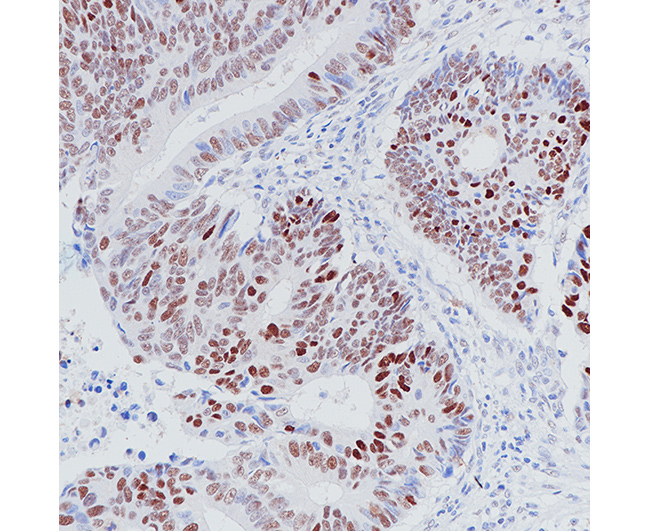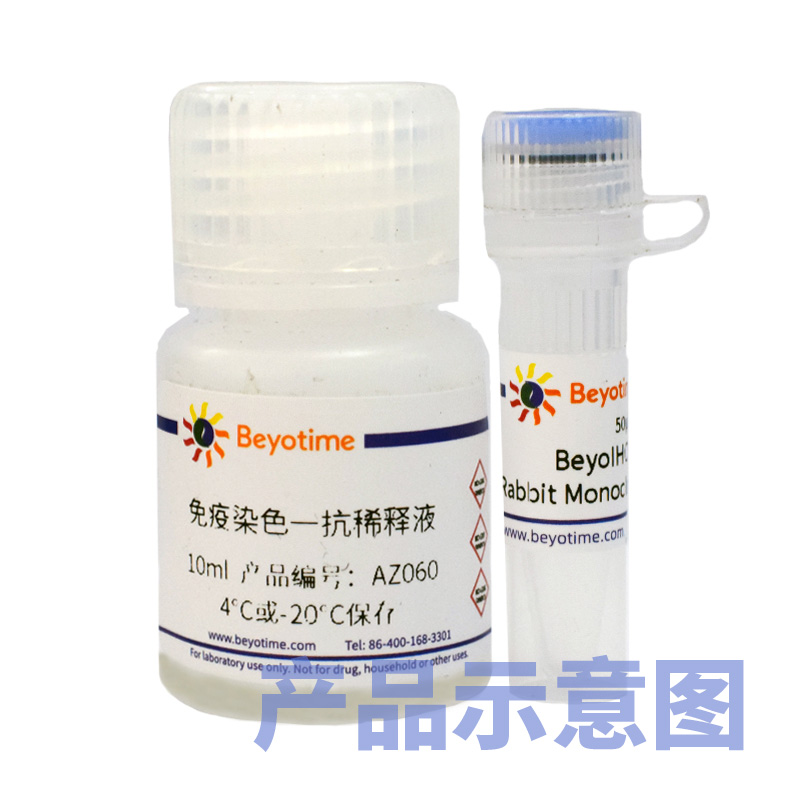


 微信在线咨询
微信在线咨询


| 产品编号 | 产品名称 | 产品包装 | 产品价格 |
| AG8593 | BeyoIHC™ p53 Mouse Monoclonal Antibody | 50μl | 758.00元 |
| 来源 | 用途 | 交叉反应性 | 理论分子量 | 实际分子量 |
| Mouse | IHC | Human | 58kDa | - |
IHC-P, Immunohistochemistry-paraffin; IHC-Fr, Immunohistochemistry-frozen; IF, Immunofluorescence;
ICC, Immunocytochemistry; WB, Western blot; FC, Flow Cytometry.
建议抗体使用时的稀释比例如下(实际使用时需根据抗原水平的高低作适当调整):
| IHC-P | IHC-Fr | IF/ICC | WB | FC |
| 1:100-1:200 | N/D (not determined) | N/D | N/D | N/D |
BeyoIHC™系列抗体是经过测试适用于免疫组织化学(Immunohistochemistry, IHC)的高品质抗体,也称病理抗体,很大一部分为重组兔单克隆抗体(Recombinant Rabbit Monoclonal Antibody),通过先进的兔单克隆抗体技术平台研发并生产,无需获取动物的脾脏,仅需分离抗原特异性B细胞并通过基因工程方法克隆抗体基因,然后在哺乳动物细胞中重组表达并最终纯化获得[1-2]。
BeyoIHC™抗体灵敏度更高,背景更低,染色更清晰,定位更精准。BeyoIHC™系列抗体通过反复的筛选和测试,确保灵敏度高、背景低、染色效果好[3]。
BeyoIHC™抗体特异性更强,染色结果更为准确。BeyoIHC™系列抗体大部分都是精心筛选的高效价单克隆抗体,是由单个B细胞淋巴瘤表达,只针对一个抗原表位发生特定的免疫反应,应用于免疫组化时特异性更强,染色结果更为准确[3]。
BeyoIHC™抗体一致性更好,批次间差异更小,结果重复性更好。BeyoIHC™系列抗体很大一部分是重组抗体,具有确定的抗体序列,使用不含任何动物源性物质培养液的哺乳细胞表达体系,生产的可重复性、一致性高,批次间差异小,可避免杂交瘤细胞制备过程中的基因丢失、基因突变和细胞株漂移等问题,所制备的重组抗体的重复性更好[3]。
BeyoIHC™系列抗体主要用于福尔马林固定石蜡包埋(Formalin fixed paraffin embedded, FFPE)样品的免疫组织化学染色(Immunohistochemistry-paraffin or Immunohistochemistry paraffin-embedded, IHC-P)。对于冰冻切片免疫组织化学(Immunohistochemistry frozen sections, IHC-Fr)、细胞免疫荧光(Immunofluorescence, IF)或免疫细胞化学(Immunocytochemistry, ICC)未经测试(Not determined)。同时,BeyoIHC™系列抗体可识别人的相应蛋白,对于小鼠等其它种属很大一部分未经测试。对于未经测试的应用及种属样品,理论上有可能是可以检测的,但须用户自行测试。
BeyoIHC™系列抗体配套提供了免疫染色一抗稀释液,可以用于IHC检测或其它适当用途时的一抗稀释。为进一步提高信噪比,推荐使用QuickBlock™免疫染色一抗稀释液(P0262)、SignalUp™免疫染色一抗稀释液(P0277)用于IHC检测。
抗体详细信息如下:
| About this Antibody | |
| Name | BeyoIHC™ p53 Mouse Monoclonal Antibody |
| Category | Recombinant Mouse Monoclonal Antibody (mAb); Primary antibody; IHC抗体 |
| Isotype | IgG |
| Clone number | BA1241 |
| Purification method | Protein A affinity purification |
| Positive samples | - |
| Cellular location | Nucleus |
| Customer validation | - |
| Epitope retrieval | Heat induced epitope retrieval with Tris-EDTA buffer (pH 9.0). |
| About the Immunogen | |
| Immunogen | Recombinant human wild type p53 protein was used as an immunogen. |
| Sequence | - |
| Gene ID | 7157 |
| SwissProt | P04637 |
| Synonyms | BCC7; BMFS5; LFS1; P53; TRP53; TP53 |
| Category | p53; Regulation of Apoptosis; PI3K/Akt Signaling; p38 MAPK Signaling |
| Background | The p53 tumor suppressor protein plays a major role in cellular response to DNA damage and other genomic aberrations. Activation of p53 can lead to either cell cycle arrest and DNA repair or apoptosis . p53 is phosphorylated at multiple sites in vivo and by several different protein kinases in vitro. DNA damage induces phosphorylation of p53 at Ser15 and Ser20 and leads to a reduced interaction between p53 and its negative regulator, the oncoprotein MDM2. MDM2 inhibits p53 accumulation by targeting it for ubiquitination and proteasomal degradation. p53 can be phosphorylated by ATM, ATR, and DNA-PK at Ser15 and Ser37. Phosphorylation impairs the ability of MDM2 to bind p53, promoting both the accumulation and activation of p53 in response to DNA damage. Chk2 and Chk1 can phosphorylate p53 at Ser20, enhancing its tetramerization, stability, and activity. p53 is phosphorylated at Ser392 in vivo and by CAK in vitro. Phosphorylation of p53 at Ser392 is increased in human tumors and has been reported to influence the growth suppressor function, DNA binding, and transcriptional activation of p53. p53 is phosphorylated at Ser6 and Ser9 by CK1δ and CK1ε both in vitro and in vivo. Phosphorylation of p53 at Ser46 regulates the ability of p53 to induce apoptosis. Acetylation of p53 is mediated by p300 and CBP acetyltransferases. Inhibition of deacetylation suppressing MDM2 from recruiting HDAC1 complex by p19 (ARF) stabilizes p53. Acetylation appears to play a positive role in the accumulation of p53 protein in stress response. Following DNA damage, human p53 becomes acetylated at Lys382 (Lys379 in mouse) in vivo to enhance p53-DNA binding. Deacetylation of p53 occurs through interaction with the SIRT1 protein, a deacetylase that may be involved in cellular aging and the DNA damage response. |
| 产品编号 | 产品名称 | 包装 |
| AG8593 | BeyoIHC™ p53 Mouse Monoclonal Antibody | 50µl |
| AZ060 | 免疫染色一抗稀释液 | 10ml |
| — | 说明书 | 1份 |
-20℃保存,一年有效。免疫染色一抗稀释液也可以4℃保存,长期不使用推荐-20℃保存,但冻融可能会导致出现轻微的浑浊和少量不溶物。
注意事项:如果本抗体用于免疫组化(IHC)等实验,请注意回收使用过的稀释抗体。回收的抗体通常可以重复使用1-5次。稀释后的抗体,包括已经使用过的稀释抗体,请4℃保存。
回收后重复使用的抗体,使用方法同新鲜稀释的抗体。如果在重复使用过程中发现抗体出现轻微混浊现象,可以10,000×g离心1-3分钟,取上清用于后续检测。如果回收的抗体出现明显的絮状物或长霉长菌等情况,则可以考虑废弃该抗体。
提供的免疫染色一抗稀释液也可以用于Western blot (WB)等适当用途。如果希望获得最佳的检测效果,推荐使用Western一抗稀释液(P0023)。
抗原修复过程中应防止缓冲液过度蒸发,切勿干片。
本产品仅限于专业人员的科学研究用,不得用于临床诊断或治疗,不得用于食品或药品,不得存放于普通住宅内。
为了您的安全和健康,请穿实验服并戴一次性手套操作。










 微信在线咨询
微信在线咨询












